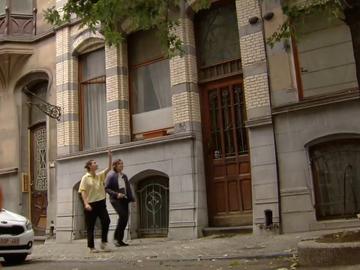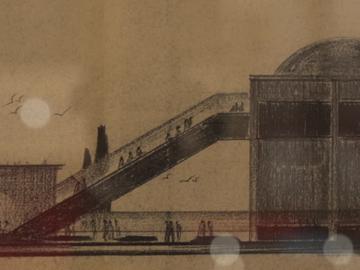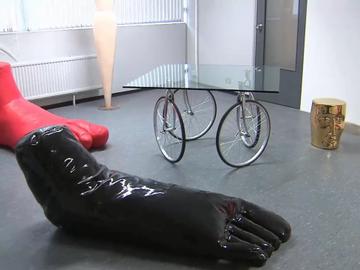Fifty years ago, the Italian radical movement Superstudio developed new ideas for life on earth. Today, these ideas have lost none of their relevance and form the core of the “Superstudio Migrazioni” exhibition at the CIVA.

An image taken from 'Il Monumento Continuo', Superstudio's most iconic project.
'Superstudio Migrazioni': architecture as a synonym for life
Adolfo Natalini and Cristiano Toraldo di Francia met in 1966 while studying architecture at the University of Florence and together, they founded the avant-garde group Superstudio. “Just as everywhere else in Europe, Italy underwent cultural and political changes in the 1960s, which led to student protests. Several of the most important radical movements, such as Superstudio but also Archizoom, 9999 and UFO, saw the light of day in Florence because the city was a conservative stronghold and Italy for a long period struggled with modernisation,” says curator Emmanuelle Chiappone-Piriou.
“Another crucial event in the emergence of the movement was the devastating flood of Florence in 1966. As part of the so-called 'mud angels', the members of the group helped save the heritage. As a result, the theme of (over)flooding became a common thread throughout their oeuvre. Just like Florence was destroyed as a masterpiece, the rational world order had to be shattered,” says the curator.
While the context is outlined in the bright yellow corridors of the exhibition space, the various rooms each highlight a specific theme. The exhibition starts with Migrazione (1969), which is the inspiration for both the title and the catalogue cover. “This abstract image of birds in flight, which was designed as a print pattern for the Italian company Abet Print, aptly depicts how Superstudio viewed architecture. Not as a way of organising our lives and our world in a rational way, but as a way of creating an atmospheric environment,” says Chiappone-Piriou.
GLOBAL MONUMENT
The first room focuses on the exhibition “Superarchitettura”, which Superstudio organised together with Archizoom in 1969 in Pistoia. For this, they transformed a small, narrow space into a colourful universe. “The title, and their own name, is an ironic allusion to concepts that at the time were new such as supermarket, super petrol or Superman. By imitating elements from the social context, they wanted to criticise and reveal the absurdity and monstrosity already present in society – in part due to capitalism,” says the curator. “At the same time, with their colourful designs they wanted to bring poetry back into an everyday life that they considered gruesome and too homogeneous.”
Over the past fifty years, Superstudio has exerted a strong influence on architecture with its radical ideas and powerful photo-collages
We are then introduced to their ideas around the grid, a concept that played a crucial role in all their later work. “Because the group had connections at the American Massachusetts Institute of Technology (MIT), they were quickly exposed to the computer technologies being developed. It was in this abstract and symbolic language that they found inspiration for their neutralising grid structure, which was intended to bring a new kind of rationalism to architecture. Like the capitalist system itself, the grid structure would enable them automatically to generate furniture such as their Misura series or even entire houses,” says Chiappone-Piriou. “The belief in the machine had to give way to a belief in a symbolic technology dimension in networks, systems and programmes.”
As architecture as such had become superfluous thanks to the grid, the group focused on the environment and the planet. In 1969, for example, they showed their most iconic project at the Trinational Biennale in Graz with Il Monumento Continuo. The original photo collage shows how they built a monument in the desert on the basis of the grid which, as a total design, had the ambition to order the whole world. In this way, Monumento offered a response to the design of the diffuse urban fabric and Superstudio saw it as the embodiment of the cosmic order on earth. “Even New York, which is built according to a grid pattern, had to comply. In the photo collage New New York (1969), the skyscrapers are caught in the grid. They are only a remnant of a chaotic time,” says Chiappone-Piriou.

The first room focuses on the exhibition “Superarchitettura”, which Superstudio organised together with the Archizoom collective in 1969.
As a reaction to the modernist idea of a minimum of existence, Superstudio argued for the complete fusion of architecture and life. From then onwards, architecture was to deal with five foundations: life, education, ceremony, love and death. That is why they transformed their grid into a network of energy and information, within which mankind could permanently migrate and evolve worldwide. The installation they built to represent this idea of “supersuperficie” for the exhibition “Italy: The New Domestic Landscape” (MoMA, 1972) has been reconstructed in CIVA, accompanied by the original video.
STIMULATING REFLECTION
Over the past fifty years, Superstudio has exerted a strong influence on architecture with its radical ideas and powerful photo-collages. “They themselves sometimes regret that the images receive more attention than the ideas they depict. Because Superstudio wanted to stimulate reflection rather than offer solutions,” says Chiappone-Piriou.
Across the entrance hall, the “Progettazione primaria” section houses Superstudio's last phase, in which they no longer tried to understand reality through the absurd, but through the analysis of pre-capitalist lifestyles. Through the study of simple objects from popular cultures, they developed a new vision of architecture as a discipline that fitted seamlessly into existence. They represented this idea in their installation La Moglie di Lot for the 1978 Venice Biennale. In it, a series of salt models of architectural archetypes, each enclosing a small object, were gradually dissolved by means of a dripping machine. The last object to appear bears the inscription: “Our life will be the only architecture.”
SUPERSTUDIO MIGRAZIONI
> 16/5, CIVA, www.civa.brussels




Fijn dat je wil reageren. Wie reageert, gaat akkoord met onze huisregels. Hoe reageren via Disqus? Een woordje uitleg.